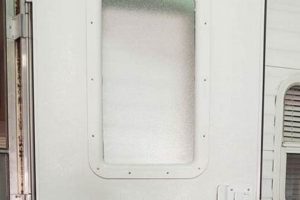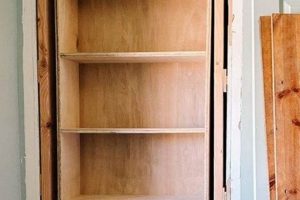Folding doors, often constructed from vinyl or wood, provide a space-saving alternative to traditional swinging doors. These doors operate by compressing multiple vertical panels together, creating a narrow stack against one side of the opening. For example, in areas where a full swinging door would obstruct traffic flow, a folding door offers a practical partition.
The significance of these adaptable partitions lies in their ability to maximize usable space and enhance the flexibility of interior design. Historically, they have been employed in confined spaces and to create adaptable room divisions. This application allows for on-demand privacy or open-concept living arrangements, adapting to various needs.
The following sections will address the process of installing and maintaining such space-saving doors, providing information on material selection, step-by-step installation guides, and essential maintenance tips. These insights aim to empower individuals to effectively manage the assembly and upkeep of these practical architectural elements.
Installation and Maintenance Tips
The following are essential guidelines to ensure proper installation and prolong the lifespan of folding doors. Attention to detail during assembly and consistent maintenance will yield optimal performance.
Tip 1: Accurate Measurements Are Critical. Precise measurements of the door opening are necessary before purchasing materials. Errors in measurement can lead to improper fitting and functional issues.
Tip 2: Select Appropriate Materials. The choice of material (e.g., vinyl, wood) should correspond with the intended environment and aesthetic preferences. Consider factors such as moisture resistance and durability.
Tip 3: Follow Manufacturer’s Instructions. Adherence to the manufacturer’s guidelines for installation is paramount. Deviations from these instructions may void warranties or compromise structural integrity.
Tip 4: Ensure Proper Track Alignment. Accurate alignment of the upper track is essential for smooth operation. Misalignment can cause binding and premature wear on the door components.
Tip 5: Lubricate Moving Parts Regularly. Routine lubrication of hinges and other moving parts with a silicone-based lubricant will minimize friction and enhance the door’s operational efficiency.
Tip 6: Inspect and Tighten Hardware. Periodically inspect all screws and fasteners, tightening them as needed. Loose hardware can compromise stability and lead to functional problems.
Tip 7: Clean the Door Surface Carefully. Use appropriate cleaning agents that are compatible with the door material to prevent damage or discoloration. Avoid abrasive cleaners that may scratch the surface.
By implementing these tips, individuals can ensure proper installation, optimal performance, and extended longevity of their folding doors. Diligence in these areas will minimize the need for costly repairs or replacements.
The final section will offer guidance on troubleshooting common issues and provide resources for further assistance.
1. Measurement Precision
Measurement precision represents a fundamental aspect of a successful folding door installation. Accurate dimensions ensure the door fits correctly within its designated space, facilitating smooth operation and preventing functional issues. Inaccurate measurements can lead to costly rework or the complete failure of the project.
- Opening Width Assessment
The precise measurement of the opening’s width dictates the overall size of the door required. A width measurement that is too small results in gaps, compromising privacy and insulation. Conversely, a width measurement that is too large necessitates trimming or alteration of the door panels, potentially affecting structural integrity and aesthetic appeal. For example, a miscalculated width can prevent the door from fully closing, leaving an unsightly and non-functional partition.
- Height Verification
Accurate height verification is equally critical. If the measured height exceeds the available space, the door may drag along the floor, causing operational difficulties and damage to both the door and the flooring. Insufficient height measurements result in gaps at the top of the door, compromising privacy and aesthetic consistency. Real-world scenarios frequently involve uneven floor surfaces, necessitating multiple height measurements to account for variations.
- Squareness Evaluation
Assessing the squareness of the door frame ensures the door panels align correctly during operation. If the frame is not square, the door may bind or fail to close properly. This issue is particularly prevalent in older structures where settling may have occurred. Correction of squareness often requires shimming or other structural adjustments before installation can proceed.
- Track Alignment Considerations
Measurement precision extends to the alignment of the upper and lower tracks. Misaligned tracks impede smooth operation and may cause the door to derail. Accurate measurements are necessary to ensure the tracks are parallel and properly spaced. The use of a laser level can aid in achieving the required precision for track installation.
These facets collectively underscore the indispensable role of measurement precision in folding door projects. Neglecting any of these considerations increases the risk of functional impairment, diminished aesthetic appeal, and the potential for costly repairs or replacements. By prioritizing accurate measurements, individuals can optimize the performance and longevity of their folding doors, ensuring a functional and visually pleasing result.
2. Material Suitability
Material suitability significantly impacts the performance, durability, and aesthetic qualities of folding door installations. The selected material must withstand the intended environment and meet specific functional requirements.
- Environmental Resistance
Different materials exhibit varying degrees of resistance to environmental factors, such as moisture, temperature fluctuations, and ultraviolet (UV) radiation. For instance, vinyl demonstrates high moisture resistance, making it suitable for bathrooms or laundry rooms, whereas solid wood may warp or rot in damp environments. Similarly, exposure to direct sunlight can cause certain plastics to fade or become brittle over time. Choosing materials with appropriate environmental resistance ensures longevity and minimizes maintenance requirements.
- Structural Integrity
The structural integrity of the material dictates its ability to withstand stress and physical impacts. Solid wood offers inherent strength and can support heavier loads, which may be relevant if the folding door serves as a barrier or security feature. Lightweight materials, such as thin vinyl, may be more susceptible to damage from impacts or repeated use. Consideration of structural integrity is vital for ensuring the door maintains its form and function over time.
- Aesthetic Compatibility
The aesthetic compatibility of the material with the existing interior design is an important consideration. Solid wood offers a natural aesthetic that complements traditional or rustic styles, while vinyl provides a cleaner, more modern appearance. The color, texture, and finish of the material should align with the overall design scheme to achieve a cohesive visual effect. Mismatched materials can detract from the aesthetic appeal of the space.
- Cost-Effectiveness
The cost-effectiveness of different materials is a practical factor in material selection. Vinyl is generally more affordable than solid wood, making it a popular choice for budget-conscious projects. However, the long-term costs associated with maintenance and replacement should also be considered. While a cheaper material may offer initial savings, a more durable and long-lasting material could prove more cost-effective in the long run. Balancing upfront costs with long-term value is essential for making informed decisions.
These facets highlight the integral relationship between material suitability and the overall success of folding door implementations. Selecting the appropriate material involves careful evaluation of environmental resistance, structural integrity, aesthetic compatibility, and cost-effectiveness. Proper consideration of these factors ensures the resulting door performs as intended, complements its surroundings, and provides lasting value.
3. Hardware Selection
The selection of appropriate hardware for folding door installations directly impacts operational smoothness, structural integrity, and overall longevity. The quality and type of hinges, tracks, handles, and fasteners significantly influence the door’s ability to function effectively over time. Substandard or mismatched hardware can cause binding, misalignment, and premature wear, ultimately compromising the door’s performance and lifespan. For instance, using hinges with inadequate weight ratings for the door panels leads to sagging and difficult operation. Similarly, tracks made from low-quality materials can deform under stress, impeding smooth movement.
Considerations for hardware selection include material composition, load-bearing capacity, corrosion resistance, and aesthetic compatibility. Stainless steel or corrosion-resistant coatings are preferable for installations in humid environments to prevent rust and maintain functionality. Furthermore, the design of handles and latches should complement the door’s style while providing secure closure and ease of use. A real-world example is the selection of heavy-duty ball-bearing hinges for a solid-core wood folding door, which ensures smooth and quiet operation despite the increased weight. Failure to choose the correct hardware can result in operational difficulties, increased maintenance costs, and a diminished lifespan for the folding door.
In summary, hardware selection is a critical component in the successful assembly of folding doors. Its impact extends beyond mere aesthetics, directly affecting functionality and durability. Challenges often arise from underestimating the importance of hardware specifications or prioritizing cost over quality. Therefore, prioritizing hardware that meets or exceeds the project’s requirements is essential for achieving a well-functioning and long-lasting partition.
4. Track Installation
Track installation represents a critical juncture in the successful implementation of folding doors. The tracks, typically mounted horizontally at the top and sometimes at the bottom of the door opening, serve as the guiding mechanism for the panels. Their correct placement directly dictates the smoothness and stability of the door’s movement. Improperly installed tracks lead to binding, uneven folding, and potentially, complete operational failure. For example, if the upper track is not perfectly level, the door panels may drift to one side, making it difficult to open and close.
The alignment and secure mounting of tracks are paramount for optimal performance. Misaligned tracks impose undue stress on the door panels and hardware, accelerating wear and tear. Secure mounting prevents the tracks from shifting over time, maintaining consistent alignment and preventing operational issues. A common example involves installations where the tracks are secured into drywall alone, without sufficient anchoring to the underlying studs. This inevitably leads to the tracks pulling away from the wall, causing the door to jam or become unusable. Correcting this requires additional reinforcement, adding to the project’s complexity and cost.
In summary, track installation is inextricably linked to the functionality and longevity of folding doors. Deviations from precise alignment and secure mounting protocols result in operational deficiencies and premature failure. By emphasizing accuracy and proper anchoring techniques during track installation, individuals can ensure their folding doors function smoothly, reliably, and for an extended period. Attention to this seemingly basic element of the process determines the overall success of the installation.
5. Panel Alignment
Within the context of folding door construction, panel alignment is a determinant factor impacting operational efficacy and aesthetic cohesion. Each panel must maintain precise vertical and horizontal alignment relative to its adjacent panels and the supporting track system. Misalignment, even of a minor degree, introduces friction, impedes smooth operation, and detracts from the visual presentation. A practical example is evident in installations where panels are not perfectly vertical; this discrepancy creates resistance during folding, leading to uneven wear on hinges and potential damage to the track system. The initial benefits derived from selecting specific materials or installation techniques will be negated if panel alignment is compromised.
Achieving and maintaining proper panel alignment necessitates meticulous attention during both installation and subsequent use. Factors contributing to misalignment include uneven floor surfaces, variations in panel thickness, and loosening of connecting hardware. To mitigate these effects, precise measurements and adjustments are crucial. Installers frequently employ shims to compensate for floor irregularities, and they thoroughly inspect and tighten all screws and fasteners. Further, periodic maintenance is essential to proactively address any gradual shifts in alignment over time.
In conclusion, panel alignment constitutes an indispensable component of a well-functioning and visually appealing folding door assembly. Its critical role extends beyond mere aesthetic considerations, directly influencing the door’s operational longevity and overall utility. Diligent attention to alignment during all phasesfrom initial installation to ongoing maintenanceis required to realize the full potential of this space-saving architectural feature.
Frequently Asked Questions
This section addresses common inquiries and clarifies important considerations related to folding door installations.
Question 1: What is the typical lifespan of folding doors?
The lifespan of folding doors varies depending on material, usage frequency, and maintenance practices. High-quality materials, coupled with regular maintenance, can extend the lifespan to 10 years or more. Conversely, low-quality materials or neglect can shorten the lifespan considerably.
Question 2: Are folding doors suitable for high-traffic areas?
While folding doors offer space-saving benefits, their suitability for high-traffic areas depends on the door’s construction. Heavy-duty folding doors, constructed from robust materials and equipped with durable hardware, can withstand frequent use. Lighter-weight models are better suited for less demanding applications.
Question 3: Can folding doors provide adequate sound insulation?
Folding doors generally provide limited sound insulation compared to solid-core doors. However, models with sound-dampening cores or tight seals can offer improved noise reduction. The level of sound insulation should be assessed based on specific needs and environmental factors.
Question 4: What are the common signs that a folding door requires repair or replacement?
Common signs include difficulty opening or closing, binding, excessive noise, visible damage to panels or hardware, and misalignment. Addressing these issues promptly can prevent further damage and extend the door’s lifespan. In some cases, replacement may be more cost-effective than extensive repairs.
Question 5: Do folding doors require specialized cleaning products?
The cleaning requirements depend on the door’s material. Vinyl doors typically require mild soap and water, while wood doors may necessitate specialized wood cleaners. Abrasive cleaners should be avoided as they can damage the door’s surface. Always consult the manufacturer’s recommendations for cleaning instructions.
Question 6: Are building permits required for folding door installations?
Building permit requirements vary depending on local regulations and the scope of the project. Consult local building codes and authorities to determine whether a permit is necessary. Structural modifications may necessitate a permit, while simple replacements often do not.
In essence, understanding these key aspects and implementing appropriate maintenance practices ensures the continued functionality and longevity of these adaptable partitions.
The subsequent section will delve into potential troubleshooting scenarios and provide resources for further assistance.
DIY Accordion Doors
This exploration has outlined the core considerations surrounding the installation and maintenance of folding doors. Emphasis has been placed on the importance of precise measurements, appropriate material selection, hardware suitability, meticulous track installation, and panel alignment. Attention to these factors directly influences the operational efficacy and lifespan of these space-saving solutions. Neglecting any of these essential elements introduces the potential for functional impairment and diminished aesthetic appeal.
The successful implementation and prolonged utility of folding doors rest on a commitment to thorough planning and diligent execution. Understanding the inherent requirements of these installations is crucial for achieving a functional and visually harmonious outcome. Further research and consultation with experienced professionals are encouraged to ensure optimal results and informed decision-making in all related endeavors.







